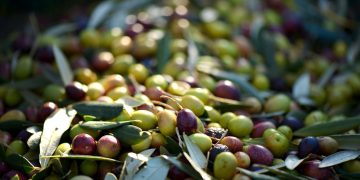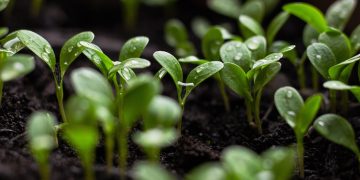When Paolo Colzi left his job in an Italian textile company 23 years ago to take over the family wheat farm, he decided to turn it organic.
Colzi says it was big risk that paid off. Now 57 years old, he is running a successful business growing wheat, tomatoes, cucumbers and aubergines on 50 hectares of land near the city of Prato in the Tuscany region.
Consumer connection
Like many small-scale agricultural producers, Colzi might have failed in his venture had he been unable to sell to local customers.
‘The only way I can get a fair price is to sell directly to people,’ he said.
More than three quarters of farms in the EU are small – under 10 hectares – and they may be central to ensuring that Europe’s food supplies are plentiful, healthy and crisis-proof.
Local production of food has become a higher priority in Europe and elsewhere in response to supply-chain disruptions caused by the Covid-19 pandemic in 2020 and Russia’s invasion of Ukraine two years later.
Yet the combination of an economic squeeze, land-access difficulties and weather extremes has led to the disappearance of many small agricultural holdings in Europe in recent decades.
In its Farm to Fork strategy in 2020, the EU said food systems need to be redesigned to allow fair economic returns for all actors, in particular primary producers.
A lot of food lands on supermarket shelves via long supply chains that can span the globe and entail multiple packaging and processing steps.
Farmers themselves may receive only a fraction of the price consumers pay in shops.
Going local
Support for small-scale farmers like Colzi has come from a European research project called COACH, which is wrapping up in October 2023 after three years.
“Public procurement may have the biggest potential to raise small farmers’ incomes.
The project received EU funding to spur cooperation among farmers, consumers, local authorities and other players in 12 European countries including Belgium, Denmark and Italy.
A prime goal has been to increase the amount of food that reaches markets through short supply chains and ensure farmers get a fair price for their produce.
Colzi is president of an association of wheat farmers, bakers, shops, restaurants and a mill in the Prato area. Called GranPrato, it was created to boost local agriculture.
Farmers sell a portion of their wheat directly to GranPrato at a price agreed at the start of each year.
In the arrangement’s first year – 2013 – GranPrato’s price was more than double the standard market one.
As it happens, the global price of wheat then soared and, in 2023, it remains higher. Even so, the farmers still sell to the association, highlighting a benefit of the agreement for consumers that Colzi says also suits him.
‘It means I don’t have to deal with sudden changes in prices, which are stressful,’ he said.
Public purses
Still, GranPrato is unable to buy all the wheat produced by the association’s 10 farmers. To do that, it would need more of its own customers by expanding the local market.
What could make a big difference is if local authorities would let GranPrato supply school meals, according to Colzi.
In the view of Moya Kneafsey, professor of food and local development at Coventry University in the UK, city authorities in general could offer a big helping hand to small local farms through contracts for meals for schools, hospitals and other public-sector catering.
‘They have the buying power to drive change,’ said Kneafsey, who coordinates COACH.
While cities work with tight budgets and usually award contracts to the cheapest suppliers, some local officials have found that prioritising sustainability isn’t more expensive. Plus interest is generally growing in the nutritional content of food in schools and hospitals.
In a separate initiative, a group of 16 cities worldwide is seeking to reduce the environmental impact of their public canteens by using organic suppliers where possible. The participants include Barcelona, Copenhagen, London, Paris, Seoul, Tokyo and Toronto.
Copenhagen’s school meals now consist of mainly organic food and the city is working on ways to source more from small local farms.
Ghent in Belgium is also seeking to rely more on local suppliers for its school meals. If those suppliers are organic, the results could be better nutrition, healthier people, prosperous local farmers, thriving rural economies and environmental gains, according to Kneafsey.
‘Of all the different initiatives, public procurement may have the biggest potential to raise small local farmers’ incomes,’ she said.
Juicy, smoothie processes
Another way for small farms to make more money is by processing their produce before selling it. That includes turning it into bread or oil, juicing fruit or drying it.
“People now realise that a large, globalised food-supply chain can be suddenly disrupted.
An EU-funded project called FOX has brought together researchers and food scientists from nine European countries, including the Czech Republic, Germany, Poland and Slovenia, to help small farms process their produce on-site or nearby.
The project, which began in mid-2019 and runs through November 2023, has built mobile units that can act as mini processing centres. Each one is about the size of a large lorry container.
‘Small-scale units could give small producers opportunities to gain value,’ said Kerstin Pasch, who coordinates FOX and heads the German Institute of Food Technologies’ office in Brussels.
One unit, which makes juices and smoothies, is being tested in small apple orchards in southern Germany.
Pasch said that, while the apple farmers were happy with the finished juices, they were concerned about the costs of buying and running the unit. Operating the units requires someone with technical training.
Economic, health benefits
FOX uses a new fruit-processing technology called pulsed electric field. By sending short electric pulses of high voltage into the juice, the technique kills microbes without reducing vitamin content.
The project has also used the technology to dry fruit and mushrooms, finding it shortens the drying time and, by extension, reduces energy costs.
Each unit costs the researchers about €400 000 to make. They say the price would likely drop if the units were produced commercially.
The team is exploring opportunities for commercialisation of the units.
‘It’s exciting thinking about these mobile small-scale solutions,’ said Pasch. ‘People now realise that a large, globalised food-supply chain can be suddenly disrupted because of a virus outbreak or a war.’
Research in this article was funded by the EU. If you liked this article, please consider sharing it on social media.
O artigo foi publicado originalmente em Horizon, the EU Research and Innovation Magazine.



















































